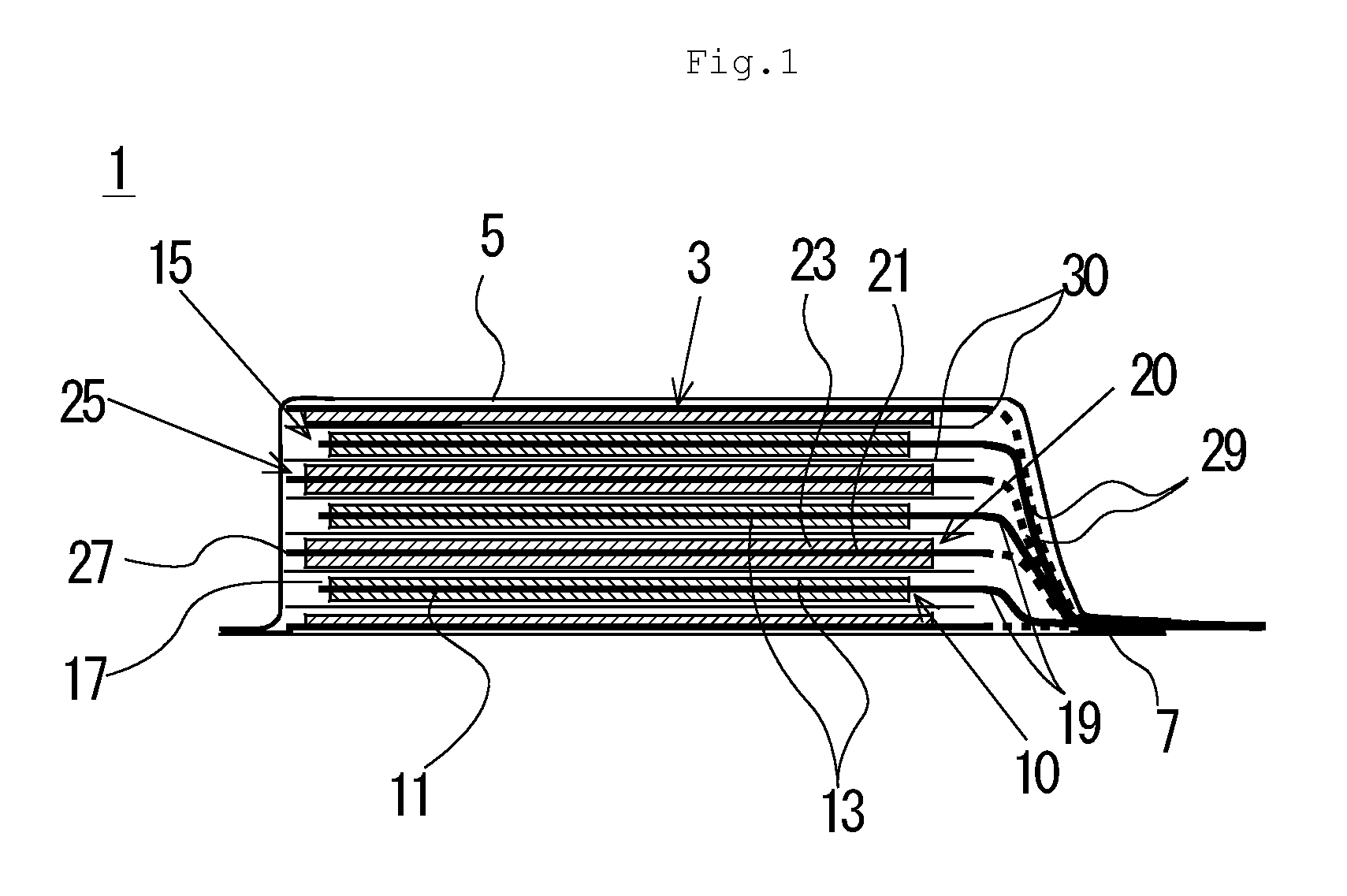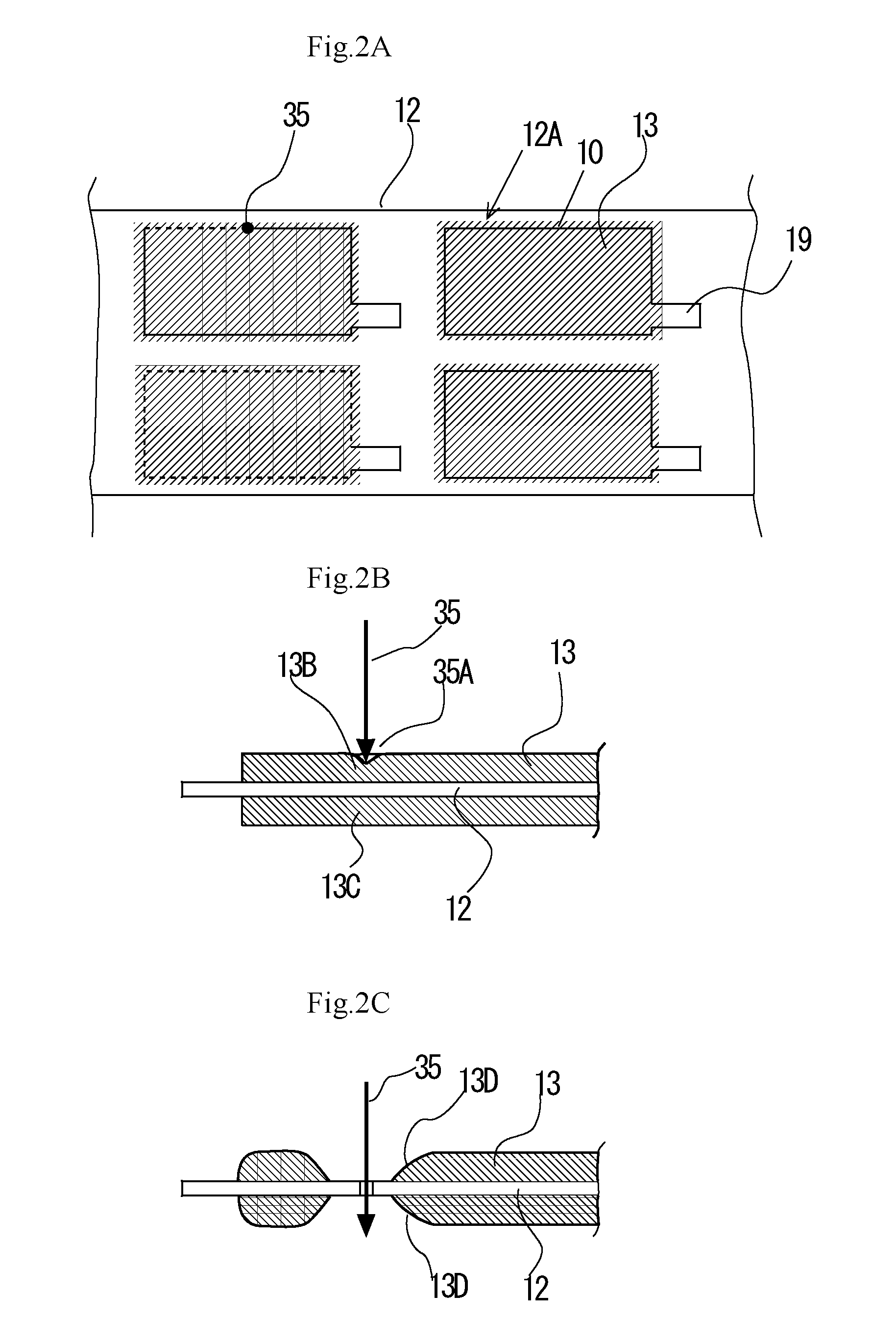Stacked secondary battery and method of manufacturing the same
a secondary battery and stacked technology, applied in the direction of batteries, sustainable manufacturing/processing, cell components, etc., can solve the problem of difficult to accurately punch out the electrode by a single punching operation, and achieve excellent charging/discharging characteristics
- Summary
- Abstract
- Description
- Claims
- Application Information
AI Technical Summary
Benefits of technology
Problems solved by technology
Method used
Image
Examples
example 1
[0056]Slurry was prepared from 63 mass portions of a lithium manganese complex oxide having a number average particle diameter of 15 micrometer, 4.2 mass portions of acetylene black having a number average particle diameter of 7 micrometer, 2.8 mass portions of polyvinylidene fluoride and 30 mass portions of N-methyl-2-pyrrolidone.
[0057]The slurry was then applied to an aluminum foil having a thickness of 20 micrometer-thick and a width of 150 mm-wide that is used for collector intermittently across the entire width of the foil to produce 20 mm-long unapplied parts and 130 mm-long applied parts. Then, the slurry was dried to produce a 180 micrometer-thick positive electrode active substance layer.
[0058]A laser beam was irradiated onto the aluminum foil by means of a YAG laser of a laser wavelength of 1,060 nm under irradiation conditions including a spot diameter of 12 micrometer, a laser output of 20 W and a laser overlapped frequency of 20 kHz to 100 kHz so as to form an electrode...
example 2
[0060]Positive electrodes were produced as in Example 1 except that a relative moving speed of 40 mm / sec of the laser beam and the positive electrode active substance layer was used to cut the aluminum foil. A photographic image of the cross section of an obtained positive electrode was taken by an optical microscope. FIG. 4 shows the obtained image.
example 3
[0063]Slurry was prepared from 49 mass portions of graphite having a number average particle diameter of 10 micrometer, 0.5 mass portions of acetylene black having a number average particle diameter of 7 micrometer, 3.5 mass portions of polyvinylidene fluoride and 47 mass portions of N-methyl-2-pyrrolidone.
[0064]The slurry was then applied to a copper foil having a thickness of 10 micrometer-thick and a width of 150 mm-wide that is used for collector intermittently across the entire width of the foil to produce 20 mm-long unapplied parts and 130 mm-long applied parts. Then, the slurry was dried to produce a 112 micrometer-thick negative electrode active substance layer.
[0065]A laser beam was irradiated twice onto the aluminum foil by means of a YAG laser of a laser wavelength of 1,060 nm under irradiation conditions including a spot diameter of 12 micrometer and a laser output of 20 W so as to form an electrode draw-out terminal having a width of 13 mm and a length of 15 mm on each ...
PUM
| Property | Measurement | Unit |
|---|---|---|
| number average particle diameter | aaaaa | aaaaa |
| number average particle diameter | aaaaa | aaaaa |
| length | aaaaa | aaaaa |
Abstract
Description
Claims
Application Information
 Login to View More
Login to View More - R&D
- Intellectual Property
- Life Sciences
- Materials
- Tech Scout
- Unparalleled Data Quality
- Higher Quality Content
- 60% Fewer Hallucinations
Browse by: Latest US Patents, China's latest patents, Technical Efficacy Thesaurus, Application Domain, Technology Topic, Popular Technical Reports.
© 2025 PatSnap. All rights reserved.Legal|Privacy policy|Modern Slavery Act Transparency Statement|Sitemap|About US| Contact US: help@patsnap.com



